|
MAGNETIC TAPE RECORDER AND REPRODUCER INFORMATION AND USE CRITERIA 1.0 Other Instrumentation Magnetic Tape Recorder Standards 2.0 Double-Density Longitudinal Recording 3.0 Serial HDDR 4.0 Head Parameters 5.0 Record Level 6.0 Tape Crossplay Considerations 7.0 Standard Tape Signature Procedures 8.0 Equipment Required for Swept-Frequency Procedures 9.0 Fixed-Frequency Plus White Noise Procedure 10.0 Signature Playback and Analysis 11.0 Recording and Playback Alignment Procedures 1.0 Other Instrumentation Magnetic Tape Recorder Standards The X3B6 Committee of the American National Standards Institute and the International Standards Organizations have prepared several standards for instrumentation magnetic tape recording. Documents may be obtained by contacting the |
|
American National Standards Institute, Inc. 1430 Broadway New York, NY 10018 Telephone (212) 354-3300 |
|
The following documents may be of interest:
|
|
ISO 1860 Information Processing - Precision reels for magnetic tape
used in interchange instrumentation applications. ISO 6068 Information Processing - Telemetry systems (including the recording characteristics of instrumentation magnetic tape) - interchange practices and recommended test methods. ISO 6371 Information Processing - Interchange requirements and test methods for unrecorded instrumentation magnetic tape. ISO 8441/1 High Density Digital Recording (HDDR) - Part 1: Unrecorded magnetic tape for HDDR applications. ISO 8441/2 High Density Digital Recording (HDDR) - Part 2: Interchange requirements and test methods for HDDR applications (including the characteristics of recorded magnetic tape). ANSI X3.175-1990 19 mm Type 1D-1 Recorded Instrumentation - Digital Cassette Tape Format. |
|
2.0 Double-Density Longitudinal Recording
2.2.1 Other Track Configurations 2.2.2 High-Density PCM Recording Wide band double-density analog recording standards allowing recording of up to 4 MHz signals at 3048 mm/s (120 ips) are included in these standards. For interchange purposes, either narrow track widths 0.635 mm (25 mils) must be employed, or other special heads must be used. These requirements are necessary because of the difficulty in maintaining individual head-segment gap-azimuth alignment across a head close enough to keep each track's response within the ±2-dB variation allowed by the standards. Moreover, at the lower tape speeds employed in double-density recording, the 38-mm (1.5-in.) spacing employed in interlaced head assemblies results in interchannel time displacement variations between odd and even tracks that may be unacceptable for some applications. For those reasons, it was decided that a 14-track in-line configuration on 25.4-mm (1-inch) tape should be adopted as a standard. This configuration results in essentially the same format as head number one of the 28-track interlaced configuration in the standards. 2.1 The 14-track interlaced heads are not compatible with tapes produced on an in-line standard configuration, and if tapes must be interchanged, a cross-configuration dubbing may be required, or a change of head assemblies on the reproducing machine is necessary. 2.2 High energy magnetic tape is required for double-density systems. Such tapes are available but may require special testing for applications requiring a low number of dropouts per track. 2.2.1 Other Track Configurations . The previously referenced standards include configurations resulting in 7, 14, and 21 tracks in addition to the 14- and 28-track configurations listed in chapter 6. The HDDR standards also reference an 84-track configuration on 50.8-mm (2-inch) tape. Figure D-1 and table D-1 show the 7 track on 12.7-mm (1/2-inch) tape, table D-2 shows the 14 track on 12.7-mm (1/2-inch) tape, and table D-3 shows the 42 track on 25.4-mm (1-inch) tape configurations. 2.2.2 High-Density PCM Recording. High-density digital recording systems are available from most instrumentation recorder manufacturers. Such systems will record at linear packing densities of 33 000-bits-per-inch or more per track. Special systems are available for error detection and correction with overhead penalties depending on the type and the sophisti-cation of the system employed. The HDDR documents listed in paragraph 1.0 of this appendix reference six different systems that have been produced; others are available. 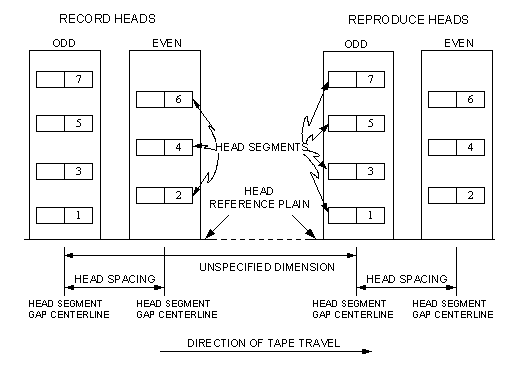 and location (7-track interlaced system). |
7 TRACKS INTERLACED ON 12.7-mm (1/2 in.) WIDE TAPE (REFER TO FIGURE 6-1). |
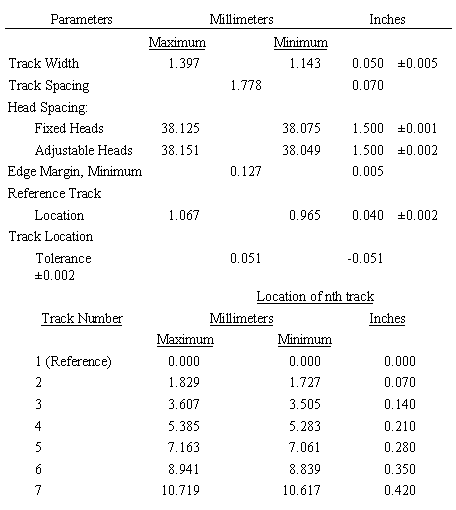 |
FORMAT, 14-TRACKS INTERLACED ON 12.7-mm (1/2 in.) WIDE TAPE (REFER TO FIGURE 6-1). |
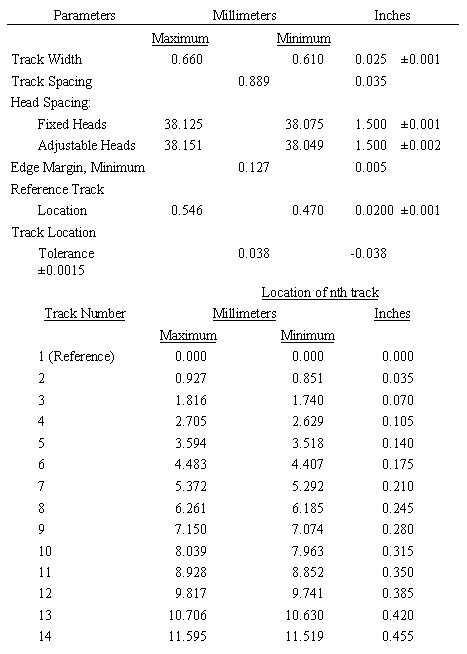 |
FORMAT, 42-TRACKS INTERLACED ON 25.4-mm (1-in.) WIDE TAPE (REFER TO FIGURE 6-1). |
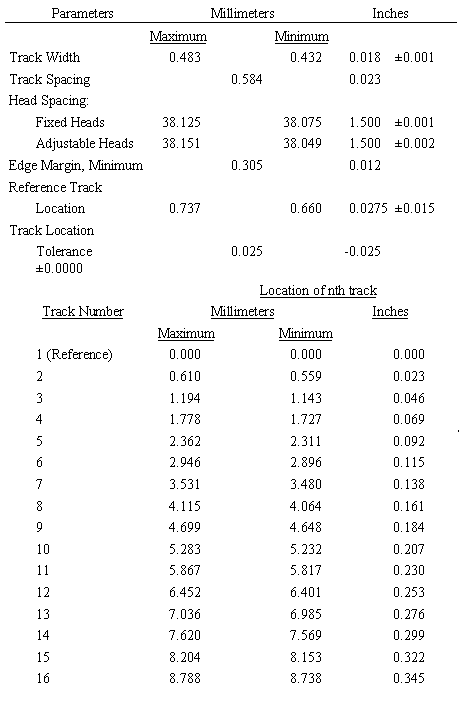 |
TAPE FORMAT, 42-TRACKS INTERLACED ON 25.4-mm (1-in.) WIDE TAPE (REFER TO FIGURE 6-1). |
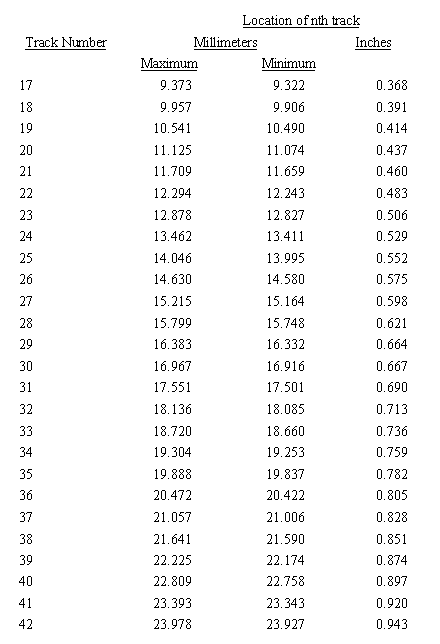 |
|
|